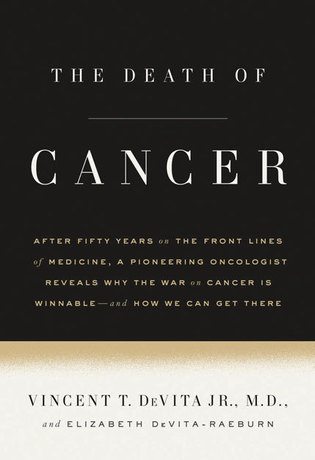
The Death of Cancer
Vincent Devita, Professor of Medicine and Epidemiology, and Elizabeth Devita Raeburn
Sarah Crichton Books, $28
Reviewed by Lisa Sanders ’97MD
Lisa Sanders ’97MD, associate professor of internal medicine and education at the Yale School of Medicine and an attending physician at Yale–New Haven Hospital, is a columnist for the New York Times.
As Vincent DeVita tells it, this most famous director of the National Cancer Institute (NCI) ended up an oncologist by accident. In the early 1960s, just out of med school and hoping to avoid Vietnam, he aimed for a stint at the National Heart Institute—but blew the interview and so landed at the NCI. “I had zero interest in cancer,” he tells us. Fortunately, that changed.
When DeVita arrived at the NCI, cancer was a death sentence. Five-year survival was 37 percent overall, and childhood cancers were virtually 100 percent fatal. Cancer was treated with surgery and radiation; those who used chemotherapeutic agents—derived from the poisons used in chemical warfare—were “reviled.” How all that changed, how chemotherapy earned its place of honor, is the subject of DeVita’s memoir, The Death of Cancer. If the historian’s job is to reveal the societal forces at work through events, it is up to the memoirist to show how individuals, their actions and choices, shaped those events. DeVita is the perfect tough-talking witness to take us through this troubled and evolving landscape.
He starts by describing the radical, disfiguring surgeries developed by the great surgeons of the time to address tumor recurrence after a “successful” operation. The motto tacked up in the office of the chief of surgery read: “If you can’t go wide, go deep.” The joke was that “when the surgeon wasn’t sure which piece of the patient to send to the pathologist, he kept the part that blinked.” Breathtaking.
Against that backdrop DeVita, with the help of his writer-daughter, skillfully walks us through the calculus of doses and combinations of poison sufficient to kill the disease but spare the patient. Today, in part because of his work, the US five-year survival rate is more than 66 percent. Childhood cancers are some of the most successfully treated. The pleasure DeVita takes in recounting these and other successes, the occasional setbacks, and how lives were saved and continue to be saved, is as readily shared as his acerbic assessments of the physicians and Food and Drug Administration bureaucrats who stood in his way. His book is a great read and a fascinating picture of what it takes to be a pioneer.
 loading
loading